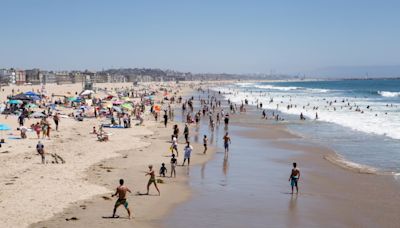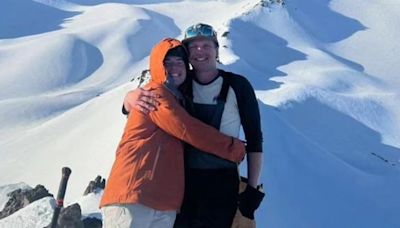Search results
About LA County. Los Angeles County, one of California’s original 27 counties, was established on Feb. 18, 1850. It is one of the nation’s largest counties with 4,084 square miles, and has the largest population of any county in the nation – nearly 10 million residents who account for approximately 27 percent of California’s population.
- Billion Years Ago
- 65 Million Years Ago
- 24 to 5 Million Years Ago
- O 1.8 Million Years Ago
- Million to 40,000 Years Ago
- About 40,000 to 10,000 Years Ago
- About 10,000 B.C.E.
- About 8,000 B.C.E.
- About 5,000 B.C.E.
- About 4,000 B.C.E.
Rock formations presently found on the present-day eastern slope of the San Gabriel Mountains begin forming beneath an ancient sea. The coastline is considerably east of its present location in what is now Utah and Idaho.
Toward the beginning of the Cenozoic Era, the Los Angeles Basin lies beneath the sea, receiving sediment from large rivers flowing out of the low-lying ancestral Nevadan mountains. Dinosaurs are extinct. The San Gabriel Mountains are beginning to form.
Exhibit of prehistoric ocean over Los Angeles 15 million years ago at Natural History Museum of Los Angeles County. Los Angeles Almanac Photo. What will become the Los Angeles area continues to lie beneath a deep subtropical sea. Before the Pacific tectonic plate upon which it lies begins shifting northward, the future Los Angeles area is located a...
What the Los Angeles area coastline may have resembled about 3-4 million years ago. Photo by Dom Carver, via Pixabay.com. Los Angeles area hills are forced upwards in height to become mountain ranges. The sea level continues to drop.
Large mountain ranges now are present and the Los Angeles basin, forming from accumulating sediment deposits, is slowly rising from the sea, eventually bringing the shoreline, about 100,000 years ago, to about where it exists today. The climate is cooler and moister than present, similar to that of the present-day Monterey Peninsula, with glacier a...
Recreated Sabre-Tooth Cat image displayed at La Brea Tar Pits & Museum. Los Angeles Almanac Photo. The Los Angeles basin is a large grassy, brush-covered and marshy plain, roamed by saber-tooth cats (once referred to as tigersto enhance the image of their ferocity), Harlan's Ground Sloth, Dire Wolves, Western Horses, Ancient Bison, Yesterday's Came...
Prehistoric La Brea Woman imagined in display at La Brea Tar Pits & Museum. Los Angeles Almanac Photo. A young women, who would later become known as La Brea Woman, dies in the La Brea Tar Pits area of Los Angeles. Her remains would later become the oldest known human remains found in the Los Angeles area, more than 10,000 years later, in 1914. Thi...
Ice-age animals named in the period above of 40,000 to 10,000 B.C.E, along with many other concurrent species, are now extinct in Southern California. The Los Angeles basin is covered in grassy plains with scattered strands of junipers and cypress trees, streams, marshes, small lakes and ponds. The climate begins to cool again.
Chumash ancestors engage in sophisticated basketry and make use of asphaltum (tar) for water-proofing. There is increased reliance on hunting and the more sophisticated technological developments such as the throwing stick, knives, drills, and fish hooks. Burials include more artifacts.
Humans appear to have abandoned the Los Angeles area. Modern archeologists speculate that dramatically dropping sea levels turn the marshy, marine life-rich wetlands, important to local human habitation, into “a brackish water lagoon."
People also ask
When did Los Angeles County become a state?
How big is Los Angeles County?
When did Los Angeles become a city?
Why was Los Angeles known as the Queen of the Cow Counties?
Los Angeles County was one of the original counties established at the time of statehood. The eastern part of the original county was set aside in 1853 as San Bernardino County. In 1866 Kern County was established with land that had previously been assigned to Tulare and Los Angeles Counties. The boundary between Los Angeles and Ventura was ...
Feb 28, 2019 · Shabdro Photo/Getty Images. Los Angeles, America’s second largest city and the West Coast’s biggest economic powerhouse, was originally settled by indigenous tribes, including the Chumash and ...
- 3 min
Los Angeles became a center of oil production in the early 20th century, and by 1923, ... northeast of Los Angeles in Inyo County, near the Nevada state line.
1848. The Treaty of Guadalupe Hidalgo is signed and the Mexican American War ends. California, along with all of what was northern Mexico, about half of the country, is ceded to the United States (February 2). Governor Mason appoints Stephen C. Foster to be Alcalde (Mayor) of Los Angeles. Stephen C. Foster, appointed first American mayor of Los ...
HISTORY TIMELINE. Los Angeles County. 1887 to 1909. Los Angeles City Oil Field in 1895 - California's top-producing oil field. Photo from Two Years of Progress in Los Angeles City and County, 1894-1895 issued by the L.A. Chamber of Commerce. Courtesy of the British Library.



